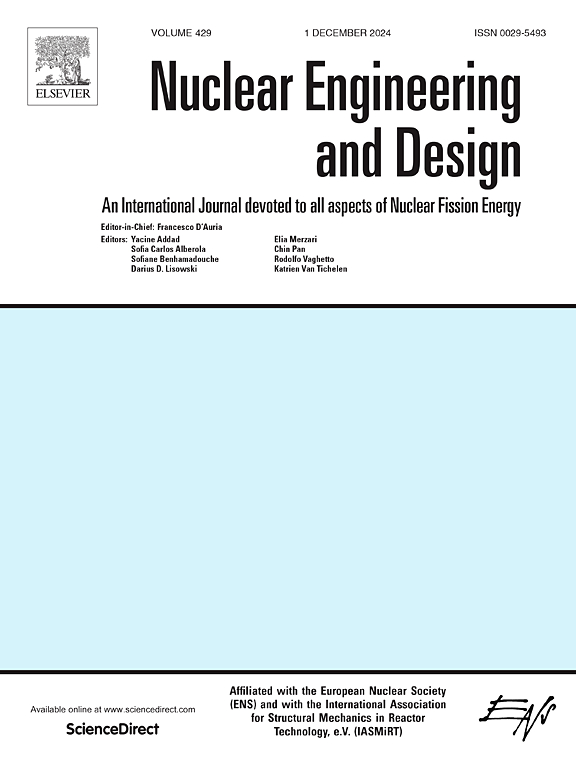Implementation of assembly shuffling for maximizing fuel utilization in the VVER-1200 reactor
IF 1.9
3区 工程技术
Q1 NUCLEAR SCIENCE & TECHNOLOGY
引用次数: 0
Abstract
This study aims to maximize reactor fuel utilization by employing assembly shuffling instead of traditional refueling. A homogeneous VVER-1200 core containing 163 fuel assemblies (4.95 wt.% enriched) and excluding control rods/absorber banks is taken as the reference and burnt for 950 EFPDs. It is found that the discharge burnup of the central 54 fuel assemblies (Zone-1) is 41.2 MWD/kg, the middle 55 assemblies (Zone-2) is 36.9 MWD/kg, and the outermost 54 assemblies (Zone-3) is 27.5 MWD/kg. Burnup of Zone-3 increased by 27.4% after interchanging fuel assemblies with those of Zone-1 at 500 EFPD, which is considered as the first cycle. Simultaneously, the keff jumped from 1.093 to 1.151, maintaining criticality up to 900 EFPD. However, further interchange of assemblies among the zones did not improve keff significantly. The fuel and moderator temperature coefficients at BOL were −1.898 pcm/K and −58.106 pcm/K respectively, and these became more negative through shuffling, especially towards the end of core life. Despite an immediate rise in radial power peaking factor, the assembly-wise linear power distribution became more uniform as burnup progressed. The beta-effective peaked immediately after shuffling but declined gradually afterwards. Although 1.16% rise in fissile 239Pu was observed in the discharged fuel, the total quantity of minor actinides and long-lived fission products decreased by 1.63%.
求助全文
约1分钟内获得全文
求助全文
来源期刊

Nuclear Engineering and Design
工程技术-核科学技术
CiteScore
3.40
自引率
11.80%
发文量
377
审稿时长
5 months
期刊介绍:
Nuclear Engineering and Design covers the wide range of disciplines involved in the engineering, design, safety and construction of nuclear fission reactors. The Editors welcome papers both on applied and innovative aspects and developments in nuclear science and technology.
Fundamentals of Reactor Design include:
• Thermal-Hydraulics and Core Physics
• Safety Analysis, Risk Assessment (PSA)
• Structural and Mechanical Engineering
• Materials Science
• Fuel Behavior and Design
• Structural Plant Design
• Engineering of Reactor Components
• Experiments
Aspects beyond fundamentals of Reactor Design covered:
• Accident Mitigation Measures
• Reactor Control Systems
• Licensing Issues
• Safeguard Engineering
• Economy of Plants
• Reprocessing / Waste Disposal
• Applications of Nuclear Energy
• Maintenance
• Decommissioning
Papers on new reactor ideas and developments (Generation IV reactors) such as inherently safe modular HTRs, High Performance LWRs/HWRs and LMFBs/GFR will be considered; Actinide Burners, Accelerator Driven Systems, Energy Amplifiers and other special designs of power and research reactors and their applications are also encouraged.
 求助内容:
求助内容: 应助结果提醒方式:
应助结果提醒方式:


